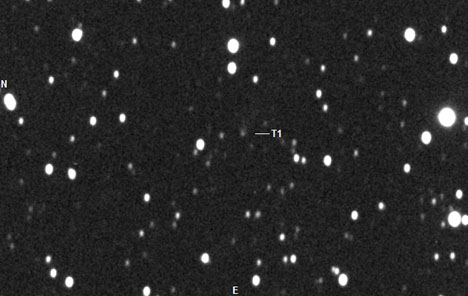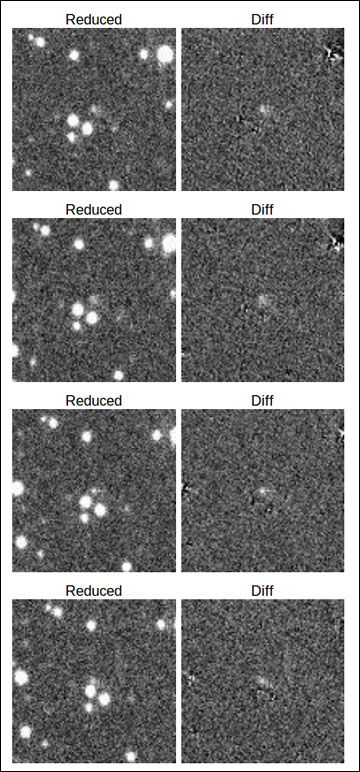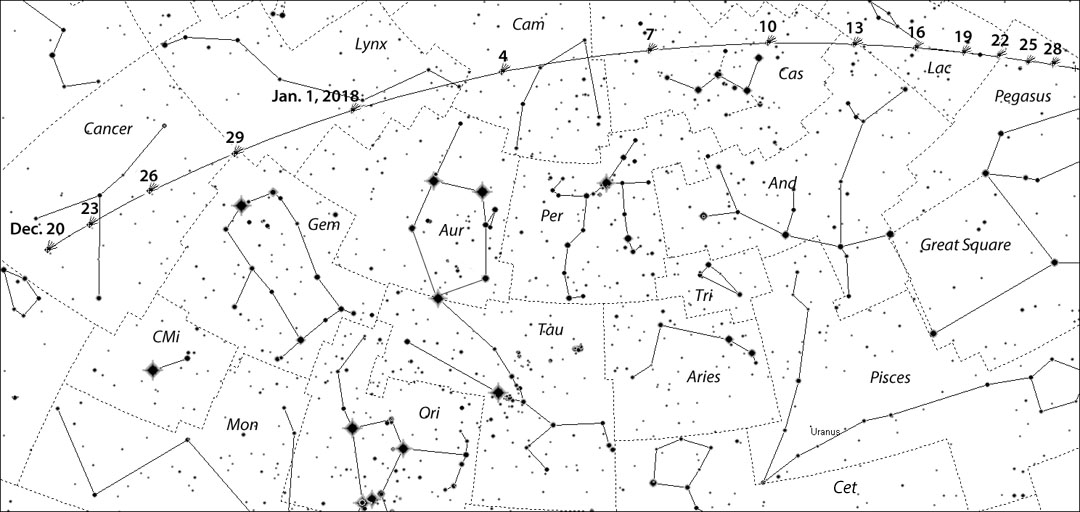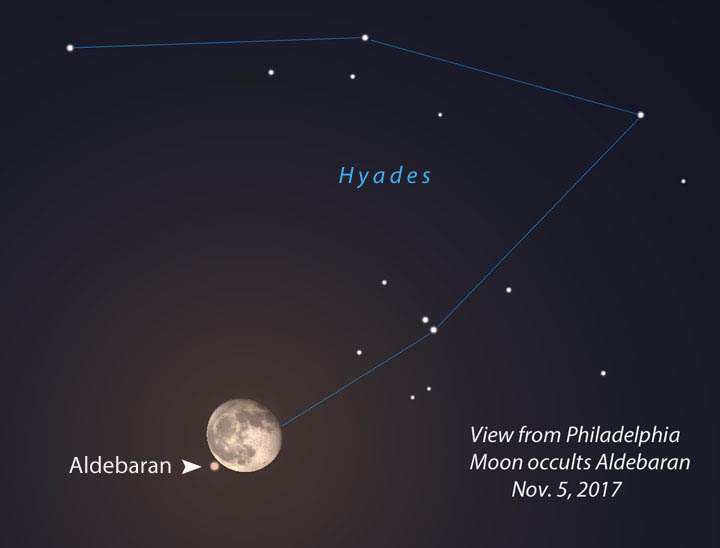Just discovered, Comet Heinze (C/2017 T) will zoom by Earth in January and may just show up in your binoculars.

Mike Olason
Ah, 2017. A year busy with binocular-bright comets has been on the quiet side lately. But the recent discovery of Comet Heinze (C/2017 T1) by the University of Hawaiʻi's Ari Heinze gives comet watchers hope for a bright and fuzzy start to the new year.
Heinze searches for near-Earth asteroids with the Asteroid Terrestrial-impact Last Alert System (ATLAS) project, and came across the comet in images taken on October 2nd. The survey uses two telescopes, one at Mauna Loa Observatory on Hawaiʻi Island, and a second on the summit of Haleakala on Maui, about 100 miles to the northwest. Among other benefits, two widely-spaced "eyes" allow for distance determination using parallax, which also helps in calculating a new object's orbit.

When first spotted on October 2nd, Comet Heinze was an 18th-magnitude crumb in Hydra with a 7″-wide coma and 10″-long tail pointing southwest. A preliminary orbit seemed to indicate that the object was an Aten-type, near-Earth asteroid spouting dust, an unprecedented discovery! To find out the truth, Heinze manually examined another set of images taken on September 28th that the computer had missed because of light from a nearby star. With the additional positions, he nailed down a better orbit and confirmed the object as a comet.
Perihelion occurs next February 21st at a distance of 87 million km, but prior to that, on January 4th, the comet will pass just 33 million km from Earth. Despite its intrinsic faintness, it's predicted to peak at magnitude 8.8 (JPL Horizons and Seichi Yoshida), putting it within range of small scopes and 50-mm or larger binoculars.

Chris Marriott's SkyMap
Heinze's proximity to the planet and steep orbital inclination of 97° makes the comet a well-placed, fast-moving object for northern hemisphere skywatchers prior to perihelion. Post-perihelion, Heinze makes a mad dash south, when it becomes accessible to southern hemisphere viewers only. Coming and going, we'll all get a shot at seeing this comet.
During November and early December, Heinze is a morning object, slowly moving north through the head of Hydra. Come mid-December, it crosses into Cancer and cracks the 12th-magnitude barrier, then picks up speed and rapidly brightens, vaulting from Cancer to Cassiopeia by January 6th. When closest, the comet will be traveling about 7° a day, or ~17′ per hour, fast enough to see movement in real time. During the first half of January, it will be circumpolar from mid-northern latitudes and visible all night.

Stellarium
On another note, the series of Moon-Aldebaran occultations that began in 2015 will soon be wrapping up, at least for U.S. observers. Two remain in 2017: The first occurs during early evening hours on November 5th (Sunday night) for the eastern 2/3 of North America; and the last on December 30th, again during evening hours for the eastern United States. The next series won't begin until 2033,16 years from now!
We're entering a particularly dry period for bright star occultations. After the final Aldebaran occultation on September 3, 2018 (visible in Greenland and the Arctic), no first-magnitude star will be occulted by the Moon for most U.S. locations until August 25, 2023, until Antares steps into those shoes. Catch 'em while you can!
 10
10









Comments
StarGazingPro
November 2, 2017 at 1:56 pm
Thanks for this news. We have been starving for binocular viewing opportunities... there seem to be so few! But we will definitely keep an eye out for this one!
You must be logged in to post a comment.
Bob KingPost Author
November 3, 2017 at 8:45 am
Hi SGP,
Like you, I remain hopeful for our little Christmas present.
You must be logged in to post a comment.
SNH
November 4, 2017 at 11:13 am
Hey Bob!
Thanks for the update on the next probable binocular comet. I think that I will be pronouncing it like the ketchup - what do you think? Thanks in large part to your quick reporting, I got to see a total of 10 comets this year in my 8x56 binoculars. The most recent addition was 24P. I saw it on the morning of October 26th and placed it right at about magnitude +10.0 even while it was in the glow of the zodiacal light. Compared it in those same binoculars to C/2017 O1 in Camelopardalis and found that it was slightly more visible (not so diffuse), so 24P is now the brightest in the sky. Thanks again Bob!
Scott
You must be logged in to post a comment.
P.Michael-Hutchins
November 4, 2017 at 11:43 am
How is UT 1 mm ss early evening?
You must be logged in to post a comment.
Bob KingPost Author
November 5, 2017 at 6:24 pm
Michale,
For U.S. locations, 1h UT is 7 p.m. the evening prior for the Central time zone, 8 p.m. for Eastern.
You must be logged in to post a comment.
Curt Renz
November 4, 2017 at 1:30 pm
Article: "After the final Aldebaran occultation on September 3, 2018 (visible in Greenland and the Arctic), no first-magnitude star will be occulted by the Moon until August 25, 2023..."
Actually, first magnitude star Regulus (mag +1.4) will be occulted seven more times before 2023. Although none of those occultations will be visible from Chicago or most North American locations.
UT dates for geocentric mid-times of Regulus occultations:
2017 NOV 11
2017 DEC 08
2018 JAN 05
2018 FEB 01
2018 MAR 01
2018 MAR 28
2018 APR 24
You must be logged in to post a comment.
Bob KingPost Author
November 5, 2017 at 6:22 pm
Hi Curt,
I should have likewise specified North America as I did with Aldebaran. Thank you for pointing this out -- I just added that caveat to the article!
You must be logged in to post a comment.
kj
January 3, 2018 at 1:16 pm
Hi Bob,
I am a total newbie with my xmas gift of an Orion Skyquest XT6 Classic Dobsion scope (48x) and definitely don't understand all the abbreviations here within your article comments. What I am trying to decipher is WHEN i should look for the Comet Heinze in SW US (phoenix, AZ) to be specific.
Thanks!
Kellie
You must be logged in to post a comment.
Bob KingPost Author
January 3, 2018 at 2:11 pm
Hi kj,
You can start looking right now. It will appear rather faint in your 6-inch but give it a try. I just did an update today at the end of this blog, which includes a link to a map: http://skyandtelescope.org/observing/mars-jupiter-conjunction/
Good luck!
You must be logged in to post a comment.
kj
January 6, 2018 at 6:02 pm
thank you!
You must be logged in to post a comment.
You must be logged in to post a comment.